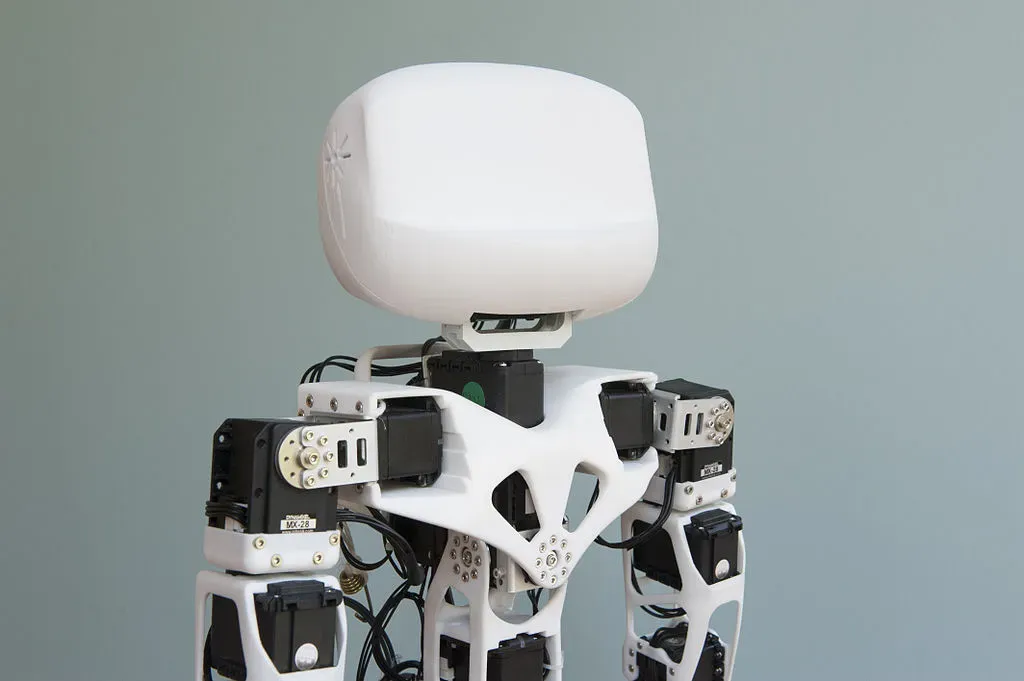The cutting-edge world of open-source humanoid robots is revolutionizing the way we think about robotics. With innovations emerging from places like UC Berkeley, these accessible creations aim to make robotics affordable and empowering for students, researchers, and enthusiasts alike. The new Berkeley Humanoid Light offers a unique solution, allowing users to construct their own robot using 3D-printed components and readily available parts, ultimately reducing costs significantly compared to traditional humanoid designs. This democratization of technology not only fosters a vibrant robot building community but also ensures that the future of humanoid robotics is in the hands of those willing to explore and innovate. In an era where affordable robot design meets cutting-edge engineering, the possibilities are limitless for aspiring roboticists eager to leave their mark on the world.
In the realm of robotics, the emergence of open-access humanoid machines is paving the way for groundbreaking advancements. UC Berkeley has spearheaded this initiative with their lightweight humanoid creation, designed to make robot assembly more attainable for a wider audience, including students and hobbyists. Leveraging 3D printing technology, this initiative showcases a new era of affordability and customization within robot fabrication. The thriving community of builders and enthusiasts shares knowledge and resources, promoting collaboration and growth in humanoid robotics. As creative minds come together around this revolutionary approach to robot design, we witness the dawn of a more inclusive future in robotics, where innovation knows no bounds.
The Future of Affordable Robot Design
Affordable robot design is pivotal for accelerating innovation in the field of robotics. As technology advances, the incorporation of 3D-printed parts and modular systems has paved the way for a new generation of builders, allowing hobbyists, students, and researchers to access robotics without a hefty financial burden. The Berkeley Humanoid Light stands out as a benchmark in this movement, demonstrating that cost-effective robotics can maintain performance standards previously reserved for high-end commercial systems.
By adopting an open-source model, the Berkeley project empowers users to not only construct their own humanoid robots but also to modify and improve them over time. This approach fosters creativity and experimentation, which are crucial in any technological field. As the robot building community continues to grow, innovation becomes more democratized, allowing diverse voices to contribute to advancements in affordable robot design.
Exploring 3D-Printed Robot Components
The integration of 3D-printed parts into the design of humanoid robots is a game-changer for aspiring builders. The Berkeley Humanoid Light utilizes these components to significantly reduce production costs while allowing customization to meet specific needs. This shift away from traditional manufacturing methods to more accessible technologies means that anyone with a 3D printer can potentially construct their own humanoid robot with relative ease.
Moreover, 3D printing fosters an environment of rapid prototyping. Builders can quickly test new ideas, revise designs, and iterate based on feedback from the robot building community. The continuous sharing of designs and improvements via platforms like Discord and GitHub creates a collaborative atmosphere, which enhances learning and accelerates development in humanoid robotics.
How UC Berkeley is Shaping Humanoid Robotics
UC Berkeley is at the forefront of innovation in humanoid robotics, driving initiatives that prioritize accessibility and affordability. The recent launch of the Berkeley Humanoid Light exemplifies their commitment to educating the next generation of roboticists. By making design files and software openly available, they are not only reducing costs but also encouraging a global community of builders to learn from each other.
The project exemplifies collaboration between academic research and community engagement. Students at UC Berkeley gain hands-on experience and contribute to real-world applications in robotics, while the larger community benefits from their research and development efforts. As this culture of sharing and innovation grows, it could lead to groundbreaking advancements in humanoid robotics, setting new standards for quality and accessibility.
The Role of Community in Advancing Robotics
Community engagement plays a crucial role in the development of open-source humanoid robots. The collaborative spirit seen in projects like the Berkeley Humanoid Light invites contributions from a wide range of participants—students, engineers, and hobbyists alike. This sharing of knowledge and resources fosters an inclusive environment where learning is accelerated, and creativity thrives.
Additionally, platforms like Discord and GitHub become vital spaces for discussion, troubleshooting, and the dissemination of best practices. The robot building community benefits significantly from this interaction, as builders can share modifications, upgrades, and personal insights into constructing robots. This sense of camaraderie not only makes robotics more accessible but also inspires the next generation to dive into the field.
Innovations in Modular Robotics Design
The modular design of the Berkeley Humanoid Light showcases a pioneering approach in humanoid robotics, allowing builders to start with one actuator and gradually expand their robot. This method reduces the intimidating barrier that often comes with building a full humanoid robot. By simplifying the assembly process, aspiring builders can test functionalities before continuing, creating a sense of accomplishment and motivation.
Modularity also enhances repairability and customizability. If a component fails, users can replace or upgrade it without needing to disassemble the entire robot. This not only fosters a deeper understanding of robotic systems but also encourages users to experiment and innovate, ensuring that the field of humanoid robotics continues to evolve rapidly.
Breaking Down Barriers to Robotics Education
The introduction of affordable open-source humanoid robots directly addresses the barriers many face when trying to engage in robotics education. Traditional robotics programs can often be prohibitively expensive and require access to specialized institutions or equipment, which can deter many enthusiastic learners. The Berkeley Humanoid Light, however, poses an opportunity for individuals and groups to access crucial robotic knowledge without exorbitant expenses.
By providing accessible designs that can be built with commonly available materials, UC Berkeley is redefining how education is approached in the robotics realm. This model opens new pathways for schools, community groups, and enthusiastic individuals to explore STEM fields, particularly where robotics is concerned, ensuring a more diverse and inclusive future for the industry.
Impact of Open-Source Robotics on Innovation
Open-source robotics projects like the Berkeley Humanoid Light ignite innovation across the field. By making designs and software freely available, users are encouraged not only to construct their own robots but also to iterate on existing designs. This free exchange of ideas allows for advancements in humanoid robotics that propel the industry forward.
The democratization of technology attracts individuals from varied backgrounds and skill levels, fostering a rich ecosystem of creativity and experimentation. As contributions from diverse creators flow into the field, hierarchical barriers dissolve, resulting in a more vibrant and responsive framework for innovation. Ultimately, open-source approaches could lead to unexpected breakthroughs that reshape our understanding of robotics.
The Significance of Lightweight Robot Design
Weight plays a critical role in the performance and functionality of humanoid robots. The Berkeley Humanoid Light, as its name suggests, is designed to be lightweight, improving mobility and efficiency. A lighter robot can facilitate better maneuverability and energy efficiency, crucial for various applications, whether educational, research-oriented, or hobbyist-driven.
Furthermore, a lightweight design can lower manufacturing costs and enhance accessibility. As enthusiasts build their own humanoid robots using 3D-printed materials and economical components, the reduced weight helps ensure that even small teams or individuals working from home can successfully create and operate their robots without needing significant resources.
The Path to Personalized Robotics
Personalization is the new frontier in the world of robotics and the Berkeley Humanoid Light exemplifies this trend. With open-source designs, builders have the freedom to tailor their robots to satisfying specific needs or preferences. This customization not only enhances the functionality of the robots but also allows individuals to express their creativity throughout the construction process.
As a result, tailored robotics can cater to a wider range of applications, from education to entertainment. The ability to modify and enhance robot features encourages builders to explore unique functionalities, leading to fresh innovations and ideas that could transform the landscape of humanoid robotics.
Frequently Asked Questions
What is the Berkeley Humanoid Light (BHL) and how does it relate to open-source humanoid robots?
The Berkeley Humanoid Light (BHL) is a lightweight, open-source humanoid robot developed by UC Berkeley that makes the design and construction of humanoid robots affordable and accessible. It utilizes 3D-printed parts and commercial components, enabling students, makers, and researchers to build their own humanoid robots with a significantly reduced budget.
How does the affordability of open-source humanoid robots impact the robot building community?
The affordability of open-source humanoid robots, like the BHL, empowers the robot building community by allowing more individuals to experiment and innovate in robotics. With lower costs and accessible designs, students and hobbyists can participate in robotics without the need for expensive equipment or proprietary systems.
What are the key features of the BHL that make it an attractive option for those interested in humanoid robotics?
The BHL features a 39-inch tall structure, weighing over 35 pounds, and is powered by modular actuators with 3D-printed cycloidal gearboxes. This design improves performance and durability, while the open-source nature ensures that builders can customize and repair the robot easily, making it especially appealing for newcomers to humanoid robotics.
How does using 3D-printed parts benefit the development of open-source humanoid robots?
Using 3D-printed parts in the development of open-source humanoid robots significantly reduces costs and resources required for construction. This method allows individuals to create robot components at home, fostering innovation and experimentation, which is essential for enhancing the robot building community.
What is the significance of modular design in the Berkeley Humanoid Light?
The modular design of the BHL allows users to start building their humanoid robot one component at a time, such as working on individual actuators before completing full limbs. This incremental approach is particularly beneficial for beginners in humanoid robotics, as it enables learning and testing without overwhelming them.
In what ways does the open-source approach enhance community participation in humanoid robotics projects?
The open-source approach of the BHL encourages community participation by providing access to hardware designs, control software, and customization options. Builders can share their experiences, improvements, and full robot builds on platforms like Discord and GitHub, fostering collaboration and fast tracking learning within the robot building community.
What are some potential barriers that still exist in the world of open-source humanoid robots?
Despite advancements like the BHL, barriers such as a lack of technical knowledge, access to 3D printers, and initial costs can still limit engagement in the world of open-source humanoid robots. Continued efforts to educate and support novice makers are crucial to overcoming these challenges.
Can students and researchers truly build humanoid robots within a limited budget using open-source designs?
Yes, students and researchers can build humanoid robots like the Berkeley Humanoid Light within a limited budget. The total cost for constructing the BHL is under $5,000, making it highly accessible compared to traditional commercial humanoid robots, which can be prohibitively expensive.
How can individuals interested in humanoid robotics get involved with the robot building community?
Individuals can get involved with the robot building community by participating in online forums, joining Discord channels, and accessing resources on GitHub dedicated to open-source humanoid robot projects like the BHL. Engaging with other community members enables learning and sharing related to humanoid robotics.
What is the future of affordable robot design in relation to advancements in humanoid robotics?
The future of affordable robot design, particularly with projects like the BHL, suggests a trend towards increased accessibility and democratization of robotics. Continued innovation in open-source designs and 3D-printing technology is likely to drive further development in humanoid robotics, making it feasible for a wider audience to engage with and contribute to the field.
| Feature | Details |
|---|---|
| Project Name | Berkeley Humanoid Light (BHL) |
| Height | Approximately 39 inches |
| Weight | Just over 35 pounds |
| Cost to Build | Less than $5,000 |
| Key Features | 3D-printed parts, modular actuators, customizable, easy to repair |
| Community Engagement | Support through Discord and GitHub; shared tips and builds |
Summary
The introduction of the Berkeley Humanoid Light (BHL) marks a transformative moment in the world of robotics. This lightweight open-source humanoid robot opens up exciting new possibilities for students, makers, and researchers by drastically reducing the barriers to entry in robotic design and construction. By utilizing 3D-printed components and commercially available parts, the BHL showcases how advanced robotics can be both affordable and customizable. Its community-driven approach not only encourages collaboration and knowledge-sharing but also democratizes the field of robotics, making innovation accessible to all. This significant shift towards open-source humanoid robots signals a promising future, where everyone has the opportunity to engage with and explore the fascinating world of robotics.



